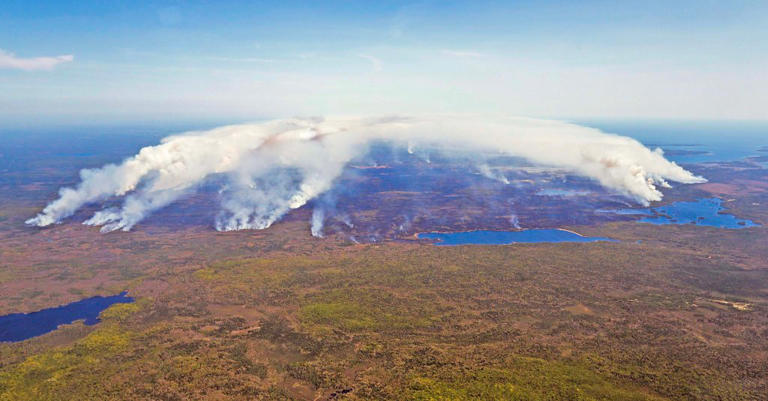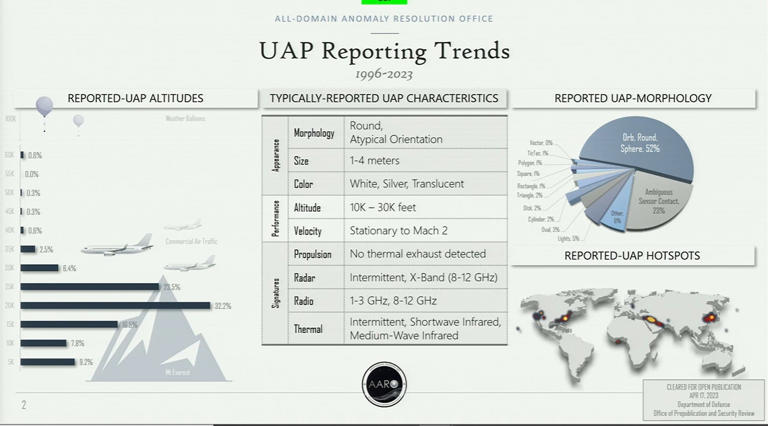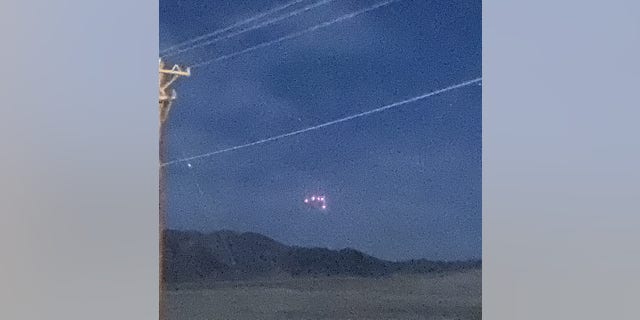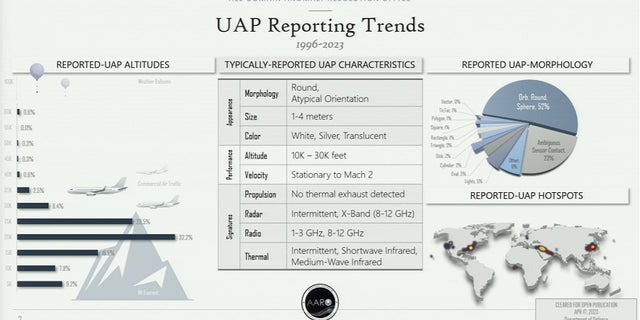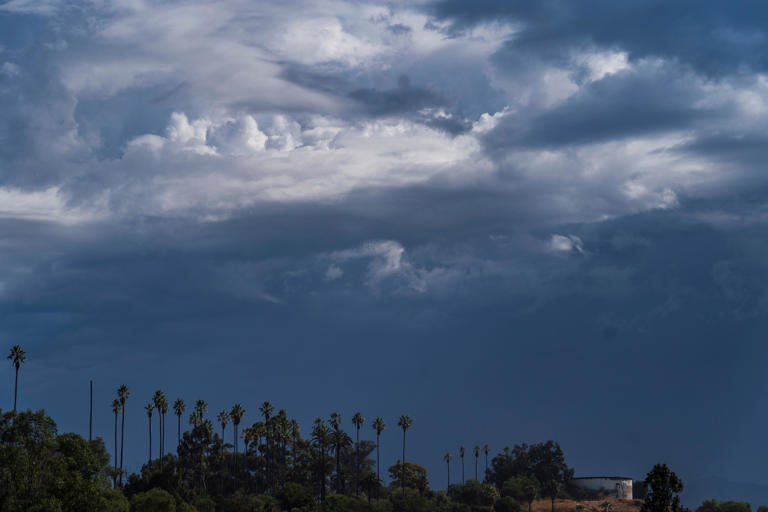Story by Melanie Haiken • Yesterday
National Geographic

A southern sea otter, an endangered subspecies, feeds on a clam in California's Monterey Bay.

A southern sea otter, an endangered subspecies, feeds on a clam in California's Monterey Bay.
Photograph By Suzi Eszterhas, Nature Picture Library
This spring, wildlife officials in California did something unusually dramatic—they sounded a public alarm over the deaths of four wild sea otters infected with an extremely rare parasite.
This strain of Toxoplasma gondii, the single-celled parasite that causes the disease toxoplasmosis, has never been recorded before in the U.S. It's also unusually virulent and could pose a threat to other mammals—including people.
The otters, found dead on California’s central coast between 2020 and 2022, had “astronomically high levels of parasites and massive numbers in the fat, which was severely inflamed,” says Melissa Miller, a wildlife veterinary specialist at the California Department of Fish and Wildlife. That’s a notable contrast to other types of toxoplasmosis, which typically affect an animal’s brain and central nervous system.
“These otters looked sicker and died faster than otters infected with other strains. We’re talking weeks rather than months or years,” says Miller, a co-author of a new study published in Frontiers in Marine Science. (Learn how this common parasite manipulates the minds of its hosts.)
Infecting at least a third of the world’s human population at any given time, Toxoplasma can only reproduce in the intestines of domestic or wild cats, which is the reason pregnant women are warned not to clean cat litter boxes. Though usually mild, the parasite is widespread in nature, affecting all warm-blooded mammals; 60 percent of adult southern sea otters have active infections, Miller says. The southern sea otter, a subspecies, is endangered in California, with only 300 animals remaining.
“These findings completely shocked us,” says Karen Shapiro, an associate professor with the University of California, Davis’ School of Veterinary Medicine.
“We’ve been characterizing other types of toxoplasmosis in sea otters for 20 years, but this was a complete doozy—a strain linked to a really severe form of disease we’ve never seen before. We needed to let people know,” says Shapiro, also a study co-author.
Genetic analysis revealed another surprise: The parasite strain was a match with samples taken from two Canadian mountain lions nearly 30 years ago. That strain, dubbed COUG for its origin, was detected and identified after residents of Victoria, British Columbia, contracted toxoplasmosis from contaminated drinking water.
People can also be exposed through their cats, or from some foods, such as undercooked meat and raw shellfish. Symptoms, if there are any, include mild fever and muscle aches—but some people, especially those who are immunocompromised, can develop severe illnesses, with damage to the brain and other organs. (Read how toxoplasmosis can impact human brains.)
At least five additional suspected COUG cases in otters are currently in various stages of testing, Shapiro adds.
“The more cases we find and the more we learn, the more we need to figure out how to protect animals and people."
Trickster parasite
After Toxoplasma enters the ocean through stormwater runoff, the parasite is picked up and concentrated by shellfish and crabs, which are favorite foods of southern sea otters. Researchers recently linked another group of T. gondii variants known as type X with cats from nearby watersheds, cementing the land-sea connection.
T. gondii can survive in seawater for as long as two years. The parasite can also go dormant for years, hiding out in cells, then reactivating if a host’s immune system weakens.
“Theyʻre considered one of the most widely successful parasites globally because they have so many tricks up their sleeves to move themselves around and hide in hosts,” Miller says.
And they may be getting a boost from increased precipitation in the West.
California's recent intense rains, flooding, and high tides, expected to intensify due to climate change, could increase the amount of Toxoplasma-infected cat fecal matter flowing into the ocean. However, Shapiro cautions more long-term studies are needed to draw solid conclusions. (Read how heavier rainfall will increase water pollution.)
To connect the dots, scientists are studying a host of different parasites and pathways by which they’re making their way through the environment. Shapiro’s research has found more Toxoplasma in mussels collected during the wet season than during the dry season, while another study linked increased levels of the parasite in the ocean with increased precipitation.
Another fatal disease
Scientists have confirmed a land-sea-rainfall connection with another parasite, Sarcocystis neuroma, which receives less attention because it isn’t a human pathogen. Hosted in possums rather than cats, sarco, as it’s called, is easier to track because the disease develops more rapidly. In one such event, 40 sea otters died on one 12-mile stretch of coastline. (Read how toxoplasmosis is harming endangered seals in Hawaii.)
“We do see a pretty close trend where usually if thereʻs a big storm that comes through, several weeks later we get an uptick in sarco cases,” says Devinn Marie Sinnott, a veterinary pathologist and Ph.D. student at UC Davis who is studying the phenomenon.
Sinnott spent the past rainy winter worried about the arrival of every new storm. “Part of me knew we needed the rain, but part of me feels dread because I know we’re going to see a lot of sick otters soon. It’s a little heartbreaking.”
The bigger picture
Meanwhile, the researchers hope that the public’s love for sea otters and other marine life will focus attention on the ways land use and development is affecting the sea environment.
“It’s not only climate change that we’re responsible for, it’s also the ways we have altered coastal environments so that there is profoundly more pollution entering the sea,” says Shapiro.
“The fact that we’ve filled in all these wetlands and paved all these parking lots and driveways means there is nowhere for the water to go other than downstream, and the water is entering the sea with much more force, carrying the parasites with it.”
What’s more, sea otters have nowhere else to go, Sinnott says. The southern sea otter’s range is limited by the rise in great white shark populations to the north and south. (Read how some sea otters are rebounding in western North America.)
“Sea otters are already under a lot of pressure from habitat loss, contact with oil spills, shark bites, and other diseases, and their population numbers are still trying to recover from their historic low,” Sinnott says.
“If we want to preserve and conserve this keystone species, we really do need to consider this land-sea connection and how climate change is affecting their population health.”
This spring, wildlife officials in California did something unusually dramatic—they sounded a public alarm over the deaths of four wild sea otters infected with an extremely rare parasite.
This strain of Toxoplasma gondii, the single-celled parasite that causes the disease toxoplasmosis, has never been recorded before in the U.S. It's also unusually virulent and could pose a threat to other mammals—including people.
The otters, found dead on California’s central coast between 2020 and 2022, had “astronomically high levels of parasites and massive numbers in the fat, which was severely inflamed,” says Melissa Miller, a wildlife veterinary specialist at the California Department of Fish and Wildlife. That’s a notable contrast to other types of toxoplasmosis, which typically affect an animal’s brain and central nervous system.
“These otters looked sicker and died faster than otters infected with other strains. We’re talking weeks rather than months or years,” says Miller, a co-author of a new study published in Frontiers in Marine Science. (Learn how this common parasite manipulates the minds of its hosts.)
Infecting at least a third of the world’s human population at any given time, Toxoplasma can only reproduce in the intestines of domestic or wild cats, which is the reason pregnant women are warned not to clean cat litter boxes. Though usually mild, the parasite is widespread in nature, affecting all warm-blooded mammals; 60 percent of adult southern sea otters have active infections, Miller says. The southern sea otter, a subspecies, is endangered in California, with only 300 animals remaining.
“These findings completely shocked us,” says Karen Shapiro, an associate professor with the University of California, Davis’ School of Veterinary Medicine.
“We’ve been characterizing other types of toxoplasmosis in sea otters for 20 years, but this was a complete doozy—a strain linked to a really severe form of disease we’ve never seen before. We needed to let people know,” says Shapiro, also a study co-author.
Genetic analysis revealed another surprise: The parasite strain was a match with samples taken from two Canadian mountain lions nearly 30 years ago. That strain, dubbed COUG for its origin, was detected and identified after residents of Victoria, British Columbia, contracted toxoplasmosis from contaminated drinking water.
People can also be exposed through their cats, or from some foods, such as undercooked meat and raw shellfish. Symptoms, if there are any, include mild fever and muscle aches—but some people, especially those who are immunocompromised, can develop severe illnesses, with damage to the brain and other organs. (Read how toxoplasmosis can impact human brains.)
At least five additional suspected COUG cases in otters are currently in various stages of testing, Shapiro adds.
“The more cases we find and the more we learn, the more we need to figure out how to protect animals and people."
Trickster parasite
After Toxoplasma enters the ocean through stormwater runoff, the parasite is picked up and concentrated by shellfish and crabs, which are favorite foods of southern sea otters. Researchers recently linked another group of T. gondii variants known as type X with cats from nearby watersheds, cementing the land-sea connection.
T. gondii can survive in seawater for as long as two years. The parasite can also go dormant for years, hiding out in cells, then reactivating if a host’s immune system weakens.
“Theyʻre considered one of the most widely successful parasites globally because they have so many tricks up their sleeves to move themselves around and hide in hosts,” Miller says.
And they may be getting a boost from increased precipitation in the West.
California's recent intense rains, flooding, and high tides, expected to intensify due to climate change, could increase the amount of Toxoplasma-infected cat fecal matter flowing into the ocean. However, Shapiro cautions more long-term studies are needed to draw solid conclusions. (Read how heavier rainfall will increase water pollution.)
To connect the dots, scientists are studying a host of different parasites and pathways by which they’re making their way through the environment. Shapiro’s research has found more Toxoplasma in mussels collected during the wet season than during the dry season, while another study linked increased levels of the parasite in the ocean with increased precipitation.
Another fatal disease
Scientists have confirmed a land-sea-rainfall connection with another parasite, Sarcocystis neuroma, which receives less attention because it isn’t a human pathogen. Hosted in possums rather than cats, sarco, as it’s called, is easier to track because the disease develops more rapidly. In one such event, 40 sea otters died on one 12-mile stretch of coastline. (Read how toxoplasmosis is harming endangered seals in Hawaii.)
“We do see a pretty close trend where usually if thereʻs a big storm that comes through, several weeks later we get an uptick in sarco cases,” says Devinn Marie Sinnott, a veterinary pathologist and Ph.D. student at UC Davis who is studying the phenomenon.
Sinnott spent the past rainy winter worried about the arrival of every new storm. “Part of me knew we needed the rain, but part of me feels dread because I know we’re going to see a lot of sick otters soon. It’s a little heartbreaking.”
The bigger picture
Meanwhile, the researchers hope that the public’s love for sea otters and other marine life will focus attention on the ways land use and development is affecting the sea environment.
“It’s not only climate change that we’re responsible for, it’s also the ways we have altered coastal environments so that there is profoundly more pollution entering the sea,” says Shapiro.
“The fact that we’ve filled in all these wetlands and paved all these parking lots and driveways means there is nowhere for the water to go other than downstream, and the water is entering the sea with much more force, carrying the parasites with it.”
What’s more, sea otters have nowhere else to go, Sinnott says. The southern sea otter’s range is limited by the rise in great white shark populations to the north and south. (Read how some sea otters are rebounding in western North America.)
“Sea otters are already under a lot of pressure from habitat loss, contact with oil spills, shark bites, and other diseases, and their population numbers are still trying to recover from their historic low,” Sinnott says.
“If we want to preserve and conserve this keystone species, we really do need to consider this land-sea connection and how climate change is affecting their population health.”
